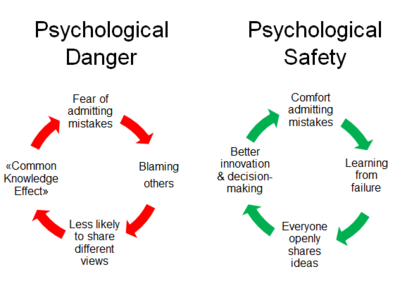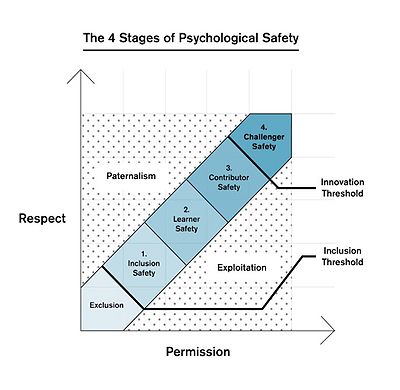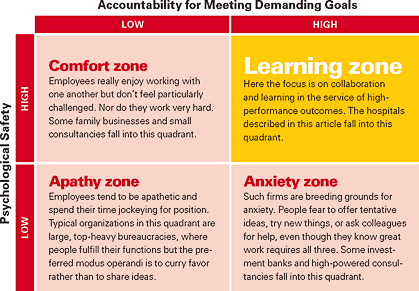Psychological safety in teams (PST)
Contents |
Short description
The wiki article on Psychological Safety is a rewrite of an existing article on the DTU Wiki page of Advanced Project, Program and Portfolio Management (APPPM) Psychological safety as a key factor to quality and productivity of Organizations. The parts that have not been edited have headers marked in Italics.
Abstract
In High performing teams the team members need to have trust in each other. It Is an essential ingredient but an important element that defines successful teams is psychological safety. The term psychological safety is in a project management context used to describe an environment where team members can freely express themselves without fear of judgement or punishment. Amy Edmonson [1]. describes Psychological safety as: “Psychological safety is a belief that one will not be punished or humiliated for speaking up with ideas, questions, concerns or mistakes.”. The description can also relate to an environment where team members feel comfortable making mistakes and sharing different beliefs. The environment is expected to lead to high-performing teams and indulge creativity, innovation and risk-taking in achieving the expected goals for the team. Psychological safety can also relate to a positive and warm working environment, where people are happier and feel comfortable [2]. By creating an environment in which team members feel safe to be themselves, managers can help release their full potential. This can lead to increased productivity, creativity, and ultimately drive success for the entire team.
Core Concept
Schein and Bennis defined psychological safety as the awareness of individuals of feeling secure and confident in their skills to manage change.[3] Posteriorly, Kahn stated that psychological safety is: “the feeling able to show and employ one's self without fear of negative consequences to self-image, status, or career”, and also argued that employees tend to feel more psychological safe when they are in a trusting and supportive environment[4]. More recently, Edmondson stated that psychological safety is more of a team-level climate, quoting: “it is a shared belief held by members of a team that the team is safe for interpersonal risk-taking” [1].
Psychological safety is then characterized by the individuals’ perception of the consequences of interpersonal risks inside the workplace. It takes into account the pre-made beliefs that individuals have regarding the reactions to their interactions (such as questions, suggestions, asking for feedback or reporting an error), and their willingness to overcome challenges through effective communication. [1] These already built beliefs are often tacit, and in most working environments there are not many opportunities to give the deserved attention by the whole team. Although sometimes these tacit beliefs may be exposed and discussed in a team meeting or interpersonal conversation, it will not affect the essence of the psychological safety of that environment. [1]
In fact, when such activities occur, they can be faced as just a protocol of an HR agenda that is not taken seriously, and the team ends up missing the point of that discussion. This is often a common trait among entities with a dubious atmosphere of psychological safety.

Difference between psychological safety and trust
Despite the overlap between the concepts trust and psychological safety, there are clear differences as well. It is generally acknowledged that the establishment of trust and respect between team members can facilitate the development of a psychologically safe environment. But these two refer to different interpersonal relationships. Trust is an individual concept, that is built over time and psychological safety is a perception on a group level. Psychological safety can also be experienced immediately compared to trust and is existing in various situations. When experiencing psychological safety the team or individual are respectfully responding to different interactions such as speaking up or questioning the status quo also when they do not agree with the interaction. If you compare this to trust is it more related to a person's belief that people behave in a certain way in the future [6] [7].
Benefits
Increased learning behavior
Psychological safety in a team allows individuals to feel comfortable asking for feedback, admitting mistakes, and sharing knowledge without fear of negative consequences. Psychological safety promotes learning behavior in work teams, leading to improved team performance and innovation. When leaders and team members encourage people to speak up and share information it will increase the learning behavior of the group and enable dem to adapt and overcome problems, which can lead to a more sustainable future [1].
Improved team performance
Team performance is positively related to psychological safety. By creating a safe and supportive work environment, individuals can work more effectively and efficiently. It will also reduce errors and improve innovative ideas. Teams with high levels of psychological safety are more likely to take calculated risks, think creatively, and experiment with new approaches, leading to better outcomes and increased success [8].
Citizenship behaviors
Psychological safety is also associated with citizenship behaviors, which are voluntary actions taken by individuals in teams that go beyond their normal work. Employees or team members who feel psychologically safe are more likely to engage in citizenship behaviors, such as helping their team members, participating in organizational initiatives, and contributing to the well-being of the team [8].
Greater team retention
If people feel safe to take risks and share their opinions, they are more expected to invest in their work because they will take ownership of their work. This will increase the team members' retention and promote commitment and loyalty to the team. The people's sense of loyalty and commitment might lead to improved satisfaction and reduced turnover because people are more likely to stay with a team that indulges psychological safety [1].
Improved creativity and innovation
If people allow individuals to experiment and take risks, organizations can benefit from fresh perspectives and innovative ideas, leading to new and improved processes, products, and services. Individuals that feel psychological safe are more likely to share new ideas and approaches [1].
Increased trust and collaboration
Trust and collaboration in teams are valuable benefits when working in an environment of psychological safety. Here individuals can feel comfortable expressing their opinions to achieve the shared goals for the team. When creating an atmosphere of respect and support, individuals are more expected to collaborate and share information, when working in teams. This will lead to improved communication and better problem solving. This collaboration can lead to a more united and effective environment, where individuals are better able to achieve their goals and succeed [1] [8].
Application
When working with psychological safety in groups the application of it is critical. The book “The 4 Stages of Psychological Safety” by T.R. Clark [7] explains the stages that drive towards creating the best environment for teams as a leader. Here the ladder of working with psychological safety can be seen in the figure, where the team members begin at the bottom of the respect and permission axis. Here the team member are excluded from the group work and not a part of the team. The leader of the group is then responsible for cultivating psychological safety as they “can either show the way or get in the way”. Here it is important to stay within the ladder and not progress too much towards Paternalism or Exploitation [7].

Stage 1: Inclusion Safety
Inclusion of safety is a human right that you as a person are accepted for being worthy based on humanity. When it comes to group work people need to feel included to establish the first stage of psychological safety. The need to feel accepted is therefore essential. When team members are invited to be a part of a group it creates a shared identity and conviction of matter. The inclusion of safety allows people to interact with members without fear of rejection or humiliation within a social unit or team. The basic need for acceptance is important to all human beings it is depriving not to feel included. Granting inclusion of safety to others acknowledge each other’s humanity and take away our differences to create a strong team. People within a group or team should ask themselves why they include some people and exclude others. Team members should exclude their personal biases and notice that every human being deserves a fundamental level of respect [7].
Stage 2: Learner Safety
An emotionally empowered learner is a cognitively enabled learner. The question for the second stage is do I feel safe to learn? This stage takes into account the need to learn and grow as an intellectual human being. It will allow the persons to feel safe in engaging in all aspects of the learning process from asking questions, giving or receiving feedback, experimenting and making mistakes. Sometimes people in group work or teams might hesitate to raise their to ask a question because they are afraid of feeling dumb. Learning is both intellectual and emotional. When the team members in a group feel learner safety, they are more willing to be vulnerable, take risks, and develop resilience in the learning process. As a part of an organization or team, we create learner safety for others to encourage them to learn instead of a willingness to learn [7].
Stage 3: Contribution Safety
Contribution safety relates to team members' need to contribute to the outcome or goals of the team. This stage relates to people’s willingness to use their skills and abilities to perform which are no longer a basic human right. Therefore it is important here to encourage others to use the specific skills with energy and enthusiasm. Every person has the desire to contribute and use what they have learned to help their team in a meaningful way towards the shared goals. This stage needs an empowering leader or team members, that encourages others to contribute and draw out the best efforts in all members of the team. When creating contributor safety for others, it empowers them with autonomy, guidance and encouragement in exchange for effort and results [7].
Stage 4: Challenger Safety
Stage 4 is the final step of the ladder and here innovation and improvement are encouraged as persons safe to challenge the status quo. People who feel safe to challenge the status quo are not afraid to speak up if there is a need for improvement. It allows people to suggest improvements and ask important questions without the risk of damaging their reputation. In this stage, people can increase the level of intellectual friction and decrease the level of social friction. It is important to take people's diversity into account here in this step as some people might find a level of fear in the challenges of being questioned for improvement. Some people might not feel comfortable in such an environment such as people with diagnoses like autism or other mental conditions. People and organisations get stuck in conservative ways if they maintain low risk-taking and certainty. Psychological safety encourages the team to trade certainty and safety for uncertainty and ambiguity. As a leader or team member it is still important to remove as much stress and uncertainty as possible. Concrete examples of improving the challenger safety could be to allocate specific responsibilities for regular meetings and have a rotating schedule to meetings so different people will be in charge each time. Also, it could be relevant to run group sessions where the new members of the team get together with the more experienced members to practice interactions and generate more innovative environment within the team [7].
Limitations
Psychological safety is not the same as being nice
Working in a psychological safe workplace does not mean that your co-workers will always smile and wave at each other, providing unconditional support and always agreeing with each other. It is not about being “nice”, in fact, some people may say it's kind of the opposite. It relies on providing an environment that is able to successfully handle disagreements, making the highly productive, and promote a free exchange of ideas. Conflicts will always happen in the workplace, and the key is not to avoid it, but to take good advantage of it. [6]
Psychological safety is not about personality
Psychological safety can be commonly mistaken with being an extrovert. Mainly due to the direct correlation between shyness and low number of interventions in the workplace. In fact, psychological safety refers to the working climate, creating an environment that will affect everyone regardless their personality. People will feel safe when voicing their ideas and concerns, regardless of whether they are extroverted or introverted. [6]
A psychological safe environment has nothing to do with being satisfied by everything the employees deliver. It does not mean that workers are not expected to meet high standards or deadlines. Psycholigcal safety relies on comfort regarding your social interactions and management of expectations, but not on an overall comfortableness on the workplace, since this would start stimulating a state of sloppiness concerning work deliveries and reaching milestones. A Psychological safety promotes frankness and openness, creating a pure environment of mutual respect. [6]

Psychological safety is not another word for trust
While trust and psychological safety share similarities, they are not synonymous. Psychological safety differs from trust in that it concerns the collective experience of a group, rather than individual interactions. This means that the experience of psychological safety is contingent on immediate circumstances. This distinction is important in understanding the role of psychological safety in team dynamics, as it is essential for fostering an environment of open communication and innovation [6].
Annotated Biography
The following list provides resources for further research and study on the Psychological Safety conceptualization, application and understanding:
- Edmondson, Amy C (1999): The Fearless Organization: Creating Psychological Safety in the Workplace for Learning, Innovation, and Growth
One of the most modern works regarding the on this topic. Focuses more on Psychological Safety in Organizations, explaining how can it be the key to rganizational learning. It Defines its importance inside companies and managerial processes, as well as a good explanation on how fragile is psychological safety and how it needs to be constinously renewed.
- Kahn, William A (1990): Psychological Conditions of Personal Engagement and Disengagement at Work
In this literary work, Kahn approached Psychological Safety from an individual perspective and tries to extrapolate it to the working environment. It addresses three main psychological conditions, meaningfulness, safety, and availability, and their contextual and individual sources.
- Schein, Edgar H.; Bennis, Warren G. (1965). Personal and organizational change through group methods
This work is more focused on a cognitive approach to the benefits of psychological safety, where it was identified as a necessary state for learning and change to take place. It focuses a lot more on its conceptualization and understanding of this newly introduced concept for that time.
- Edmondson, A. (1999a). Psychological safety and learning behavior in work teams
Edmondson explains the concept of psychological safety in work teams and explores the impact on learning behavior. The study shows that a workplace with psychological safety promotes a culture of learning and innovation, where individuals feel comfortable sharing information, making and admitting mistakes, and exploring alternative ideas.
- Clark, T. R. (2020). The 4 Stages of Psychological Safety
The book is a practical guide for leaders and team members to build a culture of psychological safety in teams and organisations. It provides a hands-on guide for how leaders establish and maintain psychological safety, where people can take risks and be vulnerable without fear of consequences. It explains 4 stages of psychological safety - Inclusion-, Learner-, Contribution-, and Challenger safety.
References
- ↑ 1.0 1.1 1.2 1.3 1.4 1.5 1.6 1.7 Edmondson, A. (1999a). Psychological safety and learning behavior in work teams. Administrative Science Quarterly, 44(2), 350-383. doi: 10.2307/2666999.
- ↑ Edmondson, A. Psychological Safety, Trust, and Learning in Organizations: A Group-level Lens. 2003.
- ↑ Schein, E., & Bennis, W. (1965). Personal and Organizational Change through Group Methods. New York: Wiley.
- ↑ Kahn, W. A. (1990). Psychological conditions of personal engagement and disengagement at work. Academy of Management Journal, 33(4), 692-724.
- ↑ https://www.weforum.org/agenda/2016/04/team-psychological-danger-work-performance/ Visited: 20/02/2021.
- ↑ 6.0 6.1 6.2 6.3 6.4 Book review: “The Fearless Organization” by Amy Edmondson. https://maa1.medium.com/book-review-the-fearless-organization-by-amy-edmondson-bfcf1b4b2d44 Visited: 20/02/2021.
- ↑ 7.0 7.1 7.2 7.3 7.4 7.5 7.6 7.7 Timothy R. Clark, "The 4 Stages of Psychological Safety," 2020 [1] (accessed Maj 05, 2023)
- ↑ 8.0 8.1 8.2 M. L. Frazier, S. Fainshmidt, R. L. Klinger, A. Pezeshkan, and V. Vracheva, Psychological Safety: A Meta-Analytic Review and Extension, Pers. Psychol., vol. 70, no. 1, pp. 113–165, 2017, doi: 10.1111/peps.12183.
- ↑ Amy Edmondson, The Fearless Organisation, p. 20.